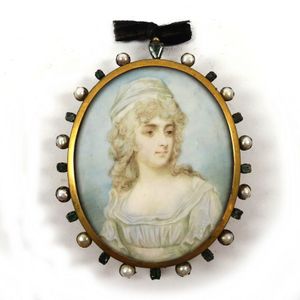Miniature Ivory Portrait with Faux Gemstones and Pearls
A hand painted miniature on ivory, a woman with flowing hair and plain day dress, the gilt frame set with pearls and faux emeralds, the back with blue foil and frame for hair or photo. 7 cm x 9.5 cm.
You must be a subscriber, and be logged in to view price and dealer details.
Subscribe Now to view actual auction price for this item
When you subscribe, you have the option of setting the currency in which to display prices to $Au, $US, $NZ or Stg.
This item has been sold, and the description, image and price are for reference purposes only.
- Faux - A French word meaning "false", but when used in decorative arts, the intention is not to deceive, but to simulate the decorative effects of the more expensive material it is imitating. The term " faux bois" meaning "false wood" refers to a furniture item that has been decorated with a marked grain (woodgrain finish) to imitate a more expensive timber.
- Ivory - Ivory is a hard white material that comes from the tusks of elephants, mammoth, walrus and boar, or from the teeth of hippopotamus and whales. The ivory from the African elephant is the most prized source of ivory. Although the mammoth is extinct, tusks are still being unearthed in Russia and offered for sale.
Ivory has been used since the earliest times as a material for sculpture of small items, both in Europe and the east, principally China and Japan.
In Asia ivory has been carved for netsuke, seals, okimono, card cases, fan supports, animals and other figures and even as carved tusks.
In the last 200 years in Europe ivory has been used to carve figures, for elaborate tankards, snuff boxes, cane handles, embroidery and sewing accessories, in jewellery and as inlay on furniture. Its more practical uses include being used for billiard balls, buttons, and a veneers on the top of piano keys.
The use and trade of elephant ivory have become controversial because they have contributed to Due to the decline in elephant populations because of the trade in ivory, the Asian elephant was placed on Appendix One of the Convention on International Trade in Endangered Species (CITES), in 1975, and in January 1990, the African elephant was similarly listed. Under Appendix One, international trade in Asian or African elephant ivory between member countries is forbidden. Unlike trade in elephant tusks, trade in mammoth tusks is legal.
Since the invention of plastics, there have been many attempts to create an artificial ivory
This item has been included into following indexes:
-
miniatures
- on ivory 366
- portrait and other 1,223
- sets or collections 151
Visually similar items

Mourning brooch. Victorian marked 9ct gold, double sided, contains two Edwardian photographs, height 3 cm
Sold by
in
for
You can display prices in $Au, $US, $NZ or Stg.

9ct gold Edwardian photo locket with seed pearls, total weight 7.8gms
Sold by
in
for
You can display prices in $Au, $US, $NZ or Stg.

An antique 9ct gold photo locket, diameter 30 mm
Sold by
in
for
You can display prices in $Au, $US, $NZ or Stg.

A coin set enamel brooch, centrally set with a Bahama's twenty dollar coin, within an enamel mount in 18ct gold
Sold by
in
for
You can display prices in $Au, $US, $NZ or Stg.
